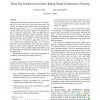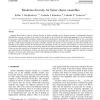785 search results - page 114 / 157 » Microarray results: how accurate are they |
BC
2007
13 years 10 months ago
2007
We consider the issue of how to read out the information from nonstationary spike train ensembles. Based on the theory of censored data in statistics, we propose a ‘censored’ m...
BMCBI
2008
13 years 10 months ago
2008
Background: Residue depth allows determining how deeply a given residue is buried, in contrast to the solvent accessibility that differentiates between buried and solvent-exposed ...
IJON
2006
13 years 10 months ago
2006
Ensembles of learning machines have been formally and empirically shown to outperform (generalise better than) single predictors in many cases. Evidence suggests that ensembles ge...
CORR
2007
Springer
13 years 10 months ago
2007
Springer
Rating-based collaborative filtering is the process of predicting how a user would rate a given item from other user ratings. We propose three related slope one schemes with pred...
INFFUS
2006
13 years 10 months ago
2006
Adjusted Rand index is used to measure diversity in cluster ensembles and a diversity measure is subsequently proposed. Although the measure was found to be related to the quality...


